#black hills powwow
Note
1, 3 and 22 for the ask game!
1. Song of the year?
Ooh so I'm gonna put two songs I listened to the most this year because I've listened to these two equally on repeat all year lol
'Last christmas' by Wham
'Can't take my eyes off you' by Boys town gang
3. Favorite musical artist/group you started listening to this year?
I haven't really started listening to any new artists or groups this year surprisingly
22. Favorite place you visited this year?
I've visited the Crazy Horse monument here in South Dakota so many times but I just love it so much, dude. Crazy Horse is actually a relative of mine on my father's side to which I'm incredibly proud of because he was the greatest warrior and horse rider within the Lakota tribe when it came to fighting against the United States federal government for trying to take over the land and wipe out the culture. Regarding the actual monument, it breaks my heart to know that we'll never see it completed within our lifetime. It's a very important symbol of strength and hope for the Native Americans here, as the man who created the monument (artist Korczak Ziolkowski) did it out of pure love and respect for our people🥲.
Honestly, fuck Mt Rushmore, if you're ever in the black hills and you wanna go sightseeing I recommend the Crazy Horse monument more than anything. The story behind its creation is so beautiful and inspiring (they show a short film about it in the theater part of the museum's main building, which fun fact has a display of my grandmother's jingle dress she wore when she became the first woman to dance a powwow after the ban on them had been lifted in 1978)
I just adore that place so much, it feels like home❤️
1 note
·
View note
Text
Black hills powwow 2022
youtube
#life#inspiration#spirituality#life quotes#shaman#inspiring quotes#quotes#spiritualawakening#spiritualism#tumbler#Youtube
0 notes
Photo

Singer
2019 Black Hills Powwow - He Sapa Wacipi
Rapid City, SD
7 notes
·
View notes
Link
South Dakota has many natural landmarks that are not only beautiful, but are sacred to the indigenous people of the plains. Of all the Native American events, the Black Hills Powwow is the best known. The 2020 Black Hills Powwow is set to run from October 9-11 at the Rapid City’s Rushmore Plaza Civic Center.

#should stay#Foothills Inn Rapid City#indigenous people#native american events#black hills powwow#rushmore plaza civic center
0 notes
Note
what would everyone in the wolfpack be doing during quarantine?
Paul- he is taking this time to just hang out tbh. He spends literally all of his time on Jacob’s couch (much to the annoyance of billy, Jacob, AND Rachel) ((he is quarantining in the black house wjdjsjdj)) and eats their food. He likes xxxtra hot Cheetos and bepsi (casual rez boy). He watches movies for the most part, but he likes to go on runs in the evenings with the rest of the pack
Sam- he spends all his time with Emily, obvi. Well, until she kicks him out of the house after he breaks a lamp for the third time while wrestling with Jared. Other than that he’s mostly just hanging out. (Un)surprisingly, Sam is a huge bookworm, he reads so much it’s not even funny. So when he isn’t pestering Emily for baked goods, wrestling with one of the boys, or out for a run, he’s sitting on the back porch reading his favorite book
Leah- she is so busy getting ripped as hell that she doesn’t really have enough time to do much else. Leah is so muscular (I’m- 😍), and she loves boxing. Mostly because it makes her feel like she invincible and also because it’s fun!! When Jacob is annoying her (like always), she challenges him to a fight and he literally always loses. And she will continue to win bc Leah is SO strong. She also has a surprisingly good signing voice, and sometimes when she’s cooling down from her workout or just kinda laying around she’ll sing to herself (no one has heard her sing and she likes to keep it that way)
Jacob- he’s literally in his garage working on his cars all the time. His latest project is to install a hand lever for the pedals in his dads truck so he can drive it once Jake leaves to go to college. On days where it’s a little too cold or he just wants to be inside, he works on carving! He does miniature sculptures of everyday objects, or sometimes he makes mini models of his friends in their wolf forms
Jared- for some reason, Jared is obsessed with the idea of doing stand up comedy. He loved Charlie Hill (a native stand up comedian) when he was growing up, and one day, about two days after quarantine went into effect, he watched one of his old tapes and got obsessed. So now he spends all his time practicing his sketches and jokes, trying to perfect them
Embry- he has been a fancy dancer since he was old enough to compete, and he practices all the time to make sure he doesn’t lose his skill. The local powwows got cancelled because of COVID but he still believes that they’re going to come back so he practices diligently. He’s also trying to get into hoop dancing. Embry is very tradish and the others tease him about it
Quil- his mom is teaching him how to bead during the pandemic because there’s not that much else to do. He’s very patient and enjoys beading because of how much focus it takes. He loves helping bead embry’s regalia because it’s his way of showing affection for his friends. He also gives every member of the pack beaded earrings (they all have their ears pierced obvi) for no reason—just leaves them on their front doorstep for them to find later
Seth- he’s the most concerned about covid, and hates when everyone else together. He has holed himself up in his room completely and hasn’t come out for weeks at this point. He assured everyone that he’s fine by looking out the closed window while they stand on his lawn and try to get him to come out. He never does. He passes all his time by watching old tv shows, and he has now watched the entirety of golden girls three times
#my post#ask#anon#twi#the wolf pack#this was SO LONG#also I have no idea if the characterization of them was right or not but I don’t really care ajdjsjdjsj this is how they are in my mind
84 notes
·
View notes
Text





Image ID under the cut since it’s long
A set of 5 Instagram slides by equityincampinginitiative with green backgrounds and white text.
Slide 1: November is Indigenous American Heritage Month. We should always be learning about and supporting Indigenous people locally and across the country, but Indigenous American Heritage Month is a great opportunity to intentionally and specifically address ways we harm Indigenous people in camp.
Slide 2:Change any Indigenous names of words being used at camp. Camps using Indigenous American Tribe names or words is harmful because it erases and undermines the significance of those worlds to the people and cultures who actually use or identify with them. Here are examples of language to eliminate at your camp: Using Indigenous American Tribe names or other words to name your groups, any activities or traditions, any locations at camp, or as your camp’s name. Any colloquially used appropriated Indigenous terms or words used to stereotype Indigenous people, such as “spirit animal,” “Powwow,” “Tribe,” “Chief,” or “savage.”
Slide 3: Avoid appropriating from Indigenous American Cultures. Using any aspect of Indigenous American culture without the consent and involvement of the people to whom that culture is significant is probably appropriation. At camp, we see this with certain activities, but more often with imagery and design. A solid pair of “camp shoes’ are essential - but some of the most popular brands with camps appropriate Indigenous designs. [image of ad for Chaco sandals “trical strips”]. These are not real camp shirts, but we have all seen this aesthetic advertised or used. Be mindful when designing your apparel for next summer. [two fake t-shirt designs, one of a mustard shirt with a brown canoe and one of a blue shirt with crossed arrows and camp emblems in white ink.]
Slide 4: Support or participate in the Land Back Movement. Does your camp own the land it occupies? Can you return some or all of that land to it’s original inhabitants? Can you work with the Tribe(s) specific to your area to make land stewardship an integral part of your program and ethical business operations? If not, can you donate to help fund those efforts elsewhere? One thing we ALL can do is support the Land Back Movement’s current main initiative, which is closing Mount Rushmore and returning the Black Hills to the many Tribes who consider it sacred land. Do we really want to protect the giant carved heads of a bunch of colonizing white supremacists? No thanks! Honoring Indigenous cultures and learning about the vast number of Tribes on this continent is important, but tangibly doing something to begin to repair the intentional damage that most of us have benefitted from is essential, We have the ability to stop the erasure of entire cultures and support the folks with hundreds of years of generational knowledge 0 so let’s do it!
Slide 5: Remember - Listen, Ask & Listen some more! No group is a monolith. The best way to know how to support the specific Tribe(s) in your local area is to ask them! For example, low-risk things like Land Acknowledgement become popular in the mainstream, however not all Tribes agree with or want Land Acknowledgement. Build relationships. Build a framework for education and address how harm towards Indigenous individuals is perpetuated at your camp. If you offer support, be prepared to get out of the way and follow their lead (these folkds know what they are doing and what they need). If you’re not sure where to start, find an issue to focus on at your camp, such as the Land Back Movement, Pipelines, or Water Preservation and activate your camp community to support it!
2 notes
·
View notes
Photo
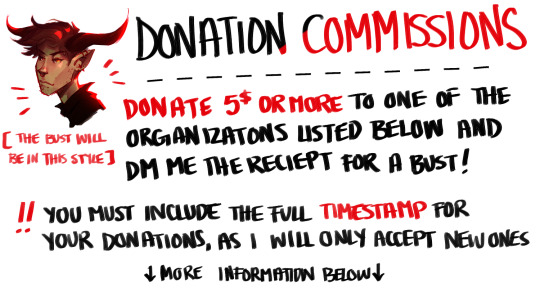
i am opening donation commissions, so if you donate more than 5$ to one of these organizations, i will draw you a bust / shoulder-up of a character of your choice, oc’s included (there are no donation tiers).
donate to:
(this blacklivesmatters carrd has the most comprehensive list of places to donate to, some links are not found here, and vise versa!)
black visions donations
black lives matter
black lives matter sacramento
reclaim the block
minnesota freedom fund
campaign zero
national police accountability project
north star health collective
unicorn riot
the black resilience fund
brave space alliance
vegas freedom fund
ctul
little earth residents association
migizi
minnesota healing justice network (paypal)
northside funders group
pimento relief fund
southside harm reduction
spiral collective
powwow grounds (donate to [email protected] via paypal, this is a native-run cafe feeding the elderly, protectors, and the community. they are also purchasing medical, fire, and cooking supplies)
or to the various victim / specific bail funds (general tw for irl death for some and violence):
George Floyd / second fundraiser made by his brother
Regis Korchinski Paquet
Chrystul Kizer
Ahmaud Marquez Arbery
Gregory Hill
James Surlock
Eric Rosalia
Jamee Johnson
Messiah Young and Taniyah Pilgrim
Brandon Saenz (huge tw for irl violence and blood)
V’s legal fund
(if you have any other links please let me know and i will edit this post)
or to black owned organizations and businesses:
black youth project 100
black women’s health imperative
center for black equity
MN bail fund and support list
marsha p. johnson institute
women for political change
blackaids
the okra project
tgi justice
browndages
wvrthy (as of june 17th their stock is all sold out but id keep checking if you like makeup!)
or any organizations on this page (tw for q slur)
or to black people and families in need:
Fitzgerald Dodd
Ron Wilkins
Jessica Mahone
Moncrease Family
Sylvia Leroy
Roy Stoddart Memorial
Steve Parker
Greene Family Fire Relief
Miss Major’s Monthly Fundraiser
community of black trans women who are sex workers and/or homeless in atlanta
pay black trans women (twitter)
gully queens of jamaica
financial assistance for black people affected by covid-19
@anya-solomon on venmo
Sai Land (tw for toxic enviroments)
Brianna Meeks
Riot Diaz
jwitman paypal or cashapp
or any of the bail funds, found on this post or on this post
community bail fund
florida bail fund
jacksonville bail fund (this also supports protesters in general, not just bails)
alachua county bail fund
as for actual art details, those are under the cut.
i will draw any character of your choice, including original characters. i will only draw one character per donation. humanoid is preferred, please. here are some art examples.
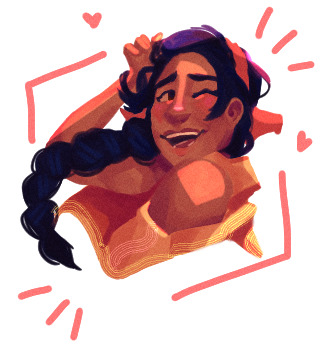

99 notes
·
View notes
Text
Native Americans Have Always Answered the Call to Serve
https://sciencespies.com/history/native-americans-have-always-answered-the-call-to-serve/
Native Americans Have Always Answered the Call to Serve
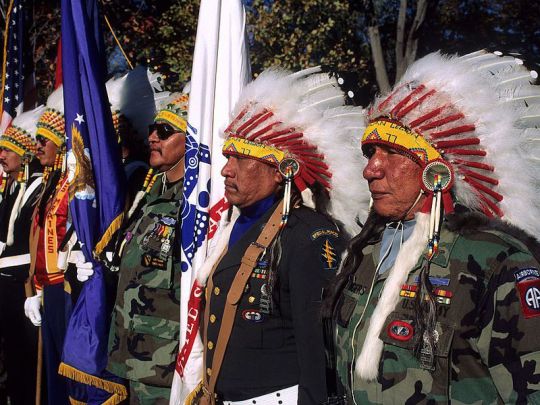
Smithsonian Voices National Museum of the American Indian
Native Americans Have Always Answered the Call to Serve: National VFW Day 2020
September 29th, 2020, 3:50PM
/ BY
Dennis Zotigh
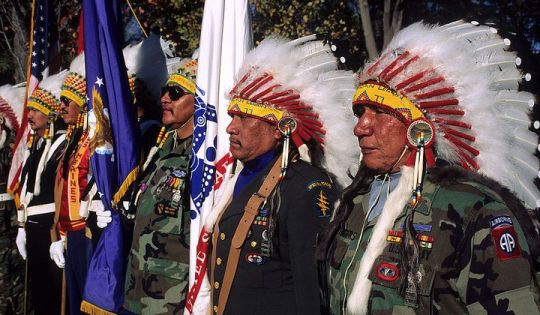
Native American veterans of the Vietnam War stand in honor as part of the color guard at the Vietnam Veterans War Memorial. November 11, 1990, Washington, D.C. (Photo by Mark Reinstein/Corbis via Getty Images)
National Veterans of Foreign Wars Day, September 29, recognizes men and women who have served honorably in a foreign war or overseas operation recognized by a campaign medal, received hostile fire, or qualified for imminent danger pay. Active-duty servicemembers who meet the criteria are also welcome. Members today include veterans of World War II, Korea, Vietnam, Lebanon, Grenada, Panama, the Balkans, the Persian Gulf, Somalia, Kosovo, Afghanistan, Iraq, and other expeditionary campaigns, as well as those who have served during occupations. Family members of eligible servicemen and women show their support through the VFW Auxiliary.
The organization’s history dates to 1899, when the American Veterans of Foreign Service and the National Society of the Army of the Philippines were organized to secure rights and benefits for veterans of the Spanish–American War (1898) and Philippine–American War (1899–1902). The two organizations merged in 1914, creating the Veterans of Foreign Wars of the United States. The VFW was chartered by Congress in 1936.
The VFW defines its role in its mission and vision statements:
To foster camaraderie among United States veterans of overseas conflicts. To serve our veterans, the military, and our communities. To advocate on behalf of all veterans.
To ensure that veterans are respected for their service, always receive their earned entitlements, and are recognized for the sacrifices they and their loved ones have made on behalf of this great country.
Today, more than 1.6 million people belong to the VFW and VFW Auxiliary. They take part in service and social programs at more than 6,000 posts, including posts on American Indian reservations and in Native communities.
In the early 1900s, the warrior tradition of American Indians seemed to face near extinction. The last of the major conflicts over Native American lands had ended a generation before, when the Agreement of 1877 annexed the Sioux homelands—including Pahá Sápa, the Black Hills—and permanently established Indian reservations. With a handful of exceptions, Native warriors no longer engaged in battle to protect their homes, families, and way of life.
“Native Americans served in World War I even though they were not citizens of the United States.” —Kevin Gover (Pawnee), director of the National Museum of the American Indian
That changed in 1917, when the United States formally entered World War I. In need of a much larger military, the federal government began to promote enlistment, and shortly afterward, instituted the draft. It is estimated that more than 12,000 American Indians served in the U.S. military during the war. At a time when a third of Native Americans were not recognized as citizens of the United States, more than 17,000 Native American men registered with the Selective Service. An estimated 12,000 Native Americans joined the U.S. Armed Forces, some 6,500 of whom were drafted, according to the records of the U.S. Office of Indian Affairs
The largest group of Native service members came from Oklahoma. Members of the Choctaw Nation of Oklahoma became the military’s first officially organized and trained group of American Indian code talkers. Students of the federal Indian boarding schools volunteered in large numbers—more than 200 from the Carlisle Indian School alone. Native Americans joined every branch of the military, including a number of Native women who volunteered for the Army Nurse Corps. Unlike African American servicemen and women, Native Americans were not segregated into special units, although there is evidence that they were often given unusually dangerous assignments. About 5 percent of Native combat soldiers were killed during World War I, compared to 1 percent of American soldiers overall.
Through the Citizenship Act of 1919, Congress granted U.S. citizenship to American Indians who had served, if they applied for it. Native Americans’ record of patriotism became the catalyst for the broader Indian Citizenship Act of 1924, which recognized all Native Americans born in the United States as citizens.
The United States’ entry into World War II brought large numbers of American Indian warriors back to the battlefield in defense of their homeland. More than 44,000 American Indians, out of a total Native American population of less than 400,000, served with distinction between 1941 and 1945 in all theaters of the war. Servicemen from more than 30 Native nations used their tribal languages as unbreakable codes to transmit vital communications. Among many Native heroes of the war is Ira Hayes (Pima [Akimel O’odham], who grew up on his parents’ farm in the Gila River Indian Community, Arizona; enlisted in the Marine Corps Reserve in 1942; and was one of six servicemen who raised the American flag over Iwo Jima, a moment immortalized at the Marine Corps Memorial.
“There is a camaraderie that transcends ethnicity when you serve your country overseas in wartime.”—Senator Ben Nighthorse Campbell (Northern Cheyenne), Korea veteran
During the Korean War (1950–1953), battle-hardened Native American troops from World War II were joined by American Indians newly recruited to fight on foreign soil. Approximately 10,000 Native Americans served in the U.S. military during this period. Seven American Indians and Native Hawaiians received Medals of Honor for their bravery and sacrifice in Korea. My uncle, William Hall-Zotigh (Kiowa), proudly served in a MASH unit near Inchon and Taegu. Before his death, he was heavily involved in the Veterans of Foreign Wars and presided over funerals for veterans on behalf of the VFW.

Native American veterans participate in opening ceremonies during the 7th Annual Indiana Traditional Powwow. April 7, 2018, Indiana University, Bloomington, Indiana. (Jeremy Hogan)
Native Americans demonstrated their patriotism again during the Vietnam era. More than 42,000 Native Americans, fought in Vietnam, more than 90 percent of them volunteers. Among the nearly 60 thousand names of individuals killed or missing in action on the Vietnam Memorial Wall are 232 identified as Native Americans or Alaska Natives.
During the 1980s and 1990s, Natives in United States military took part in combat or other hostilities in Grenada, Panama, Somalia, Bosnia and Kosovo, the Persian Gulf, Afghanistan, and Iraq. Private First Class Lori Piestewa (Hopi) was the first woman killed in action during Operation Iraqi Freedom and the first American Indian woman known to have died in combat overseas.
“I’m excited about the upcoming memorial. With the all-volunteer service, there are a lot of people who have not served or don’t understand what it means to serve. I guess I want people to recognize how often Native people have volunteered. From Alaska to the East Coast, through all the wars, Native people have always volunteered.” —Colonel Wayne Don (Cupig and Yupik), veteran of Bosnia and Afghanistan
According to the Department of Defense, more than 23,000 of the 1.2 million men and women on active duty in the U.S. military today American Indians or Alaska Natives. With the completion of the National Native American Veterans Memorial on November 11, 2020, the museum will honor them and all Native veterans. The museum will announce the larger, ceremonial opening when it is possible for veterans and their families to take part.
The National Native American Veterans Memorial is currently under construction on the grounds of the National Museum of the American Indian on the National Mall in Washington, D.C. Congress charged the museum with creating this memorial to give all Americans the opportunity “to learn of the proud and courageous tradition of service of Native Americans.” Their legacy deserves our recognition.
Join us in recognizing the members and mission of the VFW on social media using the hashtag #VFWDay.
Dennis W. Zotigh (Kiowa/San Juan Pueblo/Santee Dakota Indian) is a member of the Kiowa Gourd Clan and San Juan Pueblo Winter Clan and a descendant of Sitting Bear and No Retreat, both principal war chiefs of the Kiowas. Dennis works as a writer and cultural specialist at the Smithsonian National Museum of the American Indian in Washington, D.C.
More From This Author »
#History
2 notes
·
View notes
Video
youtube
Liked on YouTube: WAR PAINT CONTEST INTERTRIBAL @ BLACK HILLS POWWOW 2019 https://youtu.be/nI5pDBIbmX8
2 notes
·
View notes
Video
Black Hills Pow Wow...Where men,women,and children dance together for our Culture.♥ #blackhillspowwow #proud #tradition #lakota #nativeamerican #memories (at Black Hills Powwow) https://www.instagram.com/p/BLcos1whrhhJAC5_ZBe-Aftp24Hc7YJbdl2XmM0/?igshid=3f9edyuo3mpd
2 notes
·
View notes
Text
On this Thanksgiving, I’m going to give thanks for some of my favourite First Nations artists who continue to fight the good fight against colonialism
(that I have to research as part of my final exam anyway)
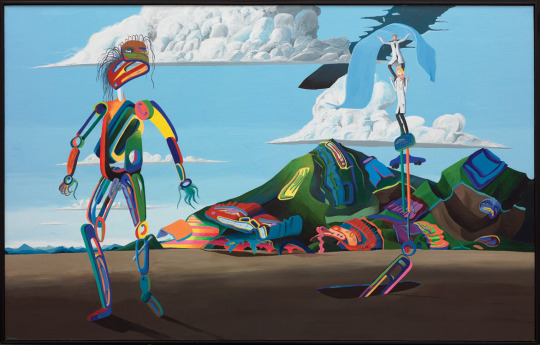

Lawrence Paul Yuxweluptun, Coast Salish and Okanogan, born 1957. Surrealist painter, history painter, and creator of the Manifesto of Ovoidism. Featured here are his paintings “Red Man Watching White Man Fix Hole In Sky” (1990), and “The Fish Farmers They Have Sea Lice”.*

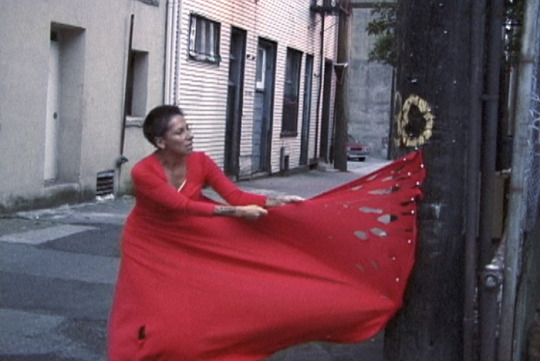
Rebecca Belmore, Anishnaabe, born 1960. Performance artist, sculptor, and activist. Pictured here are her works “Ayum-ee-aawach Oomama-mowan: Speaking to Their Mother” (1991) (a sculpture in response to the Oka Crisis in Quebec) and “Vigil” (2002) (a response to the missing and murdered Indigenous women in the downtown east side of Vancouver, BC).
youtube

James Luna, Payómkawichum, Ipi, and Mexican-American (1920-2018). Photographer and performance artist. Featured above are his works “Take A Picture With A Real Indian” (2010) and “Half Indian/Half Mexican”. Here’s his memorial article.**
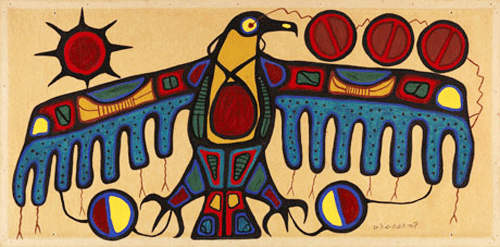
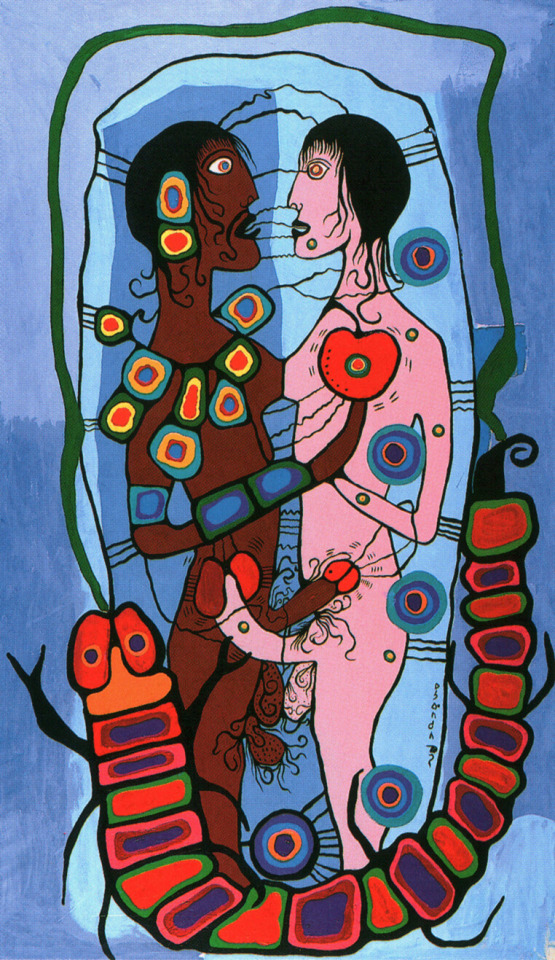
Norval Morrisseau, Anishnaabe, 1931-2007. Painter. Founder of the Woodland School of Canadian Painting and a member of the “Indian Group of Seven”. Pictured above are his famous “Thunderbird” print (1960) and “Indian Erotic Fantasy” (n.d.).

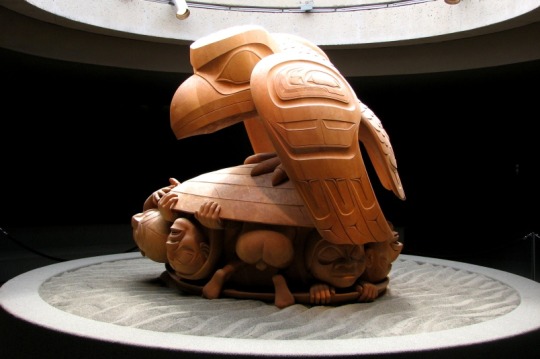
Bill Reid, Haida, (1920-1998). Hugely influential Canadian sculptor who had an enormous impact on the art world surrounding the work of First Nations artists. Pictured above is “The Spirit of Haida Gwaii” and “Raven and the First Men”.
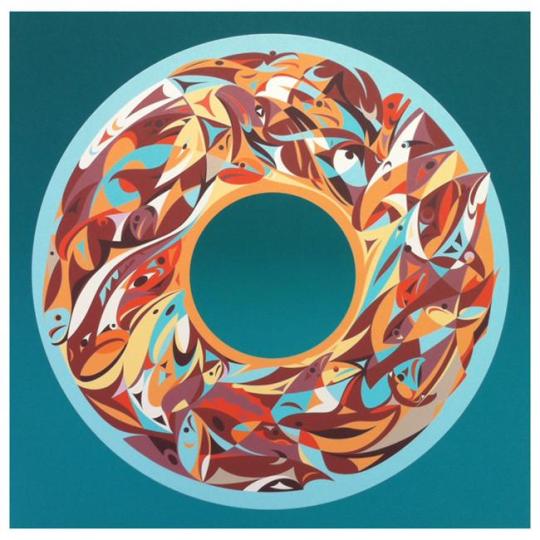

Susain Point, Musqueam Coast Salish, (born 1952). Printmaker. Pictured above are “Beyond the Edge” (2015) and “Transformation” (2005).


Edgar Heap of Birds, Southern Cheyenne, (born 1954). Mixed media. Pictured above are two examples of his work from two of his series “Native Hosts” and “Genocide and Democracy: Secrets of Life and Death”.
And now for some writers!
I highly encourage you to read some of these books if you can.
The Absolutely True Diary of a Part Time Indian by Sherman Alexie. You can find a free PDF here, or buy a copy here!
Bestselling author Sherman Alexie tells the story of Junior, a budding cartoonist growing up on the Spokane Indian Reservation. Determined to take his future into his own hands, Junior leaves his troubled school on the rez to attend an all-white farm town high school where the only other Indian is the school mascot.
Monkey Beach by Eden Robinson*. You can buy it here!
As she races along Canada’s Douglas Channel in her speedboat—heading toward the place where her younger brother Jimmy, presumed drowned, was last seen—twenty-year-old Lisamarie Hill recalls her younger days. A volatile and precocious Native girl growing up in Kitamaat, the Haisla Indian reservation located five hundred miles north of Vancouver, Lisa came of age standing with her feet firmly planted in two different worlds: the spiritual realm of the Haisla and the sobering “real” world with its dangerous temptations of violence, drugs, and despair. From her beloved grandmother, Ma-ma-oo, she learned of tradition and magic; from her adored, Elvis-loving uncle Mick, a Native rights activist on a perilous course, she learned to see clearly, to speak her mind, and never to bow down. But the tragedies that have scarred her life and ultimately led her to these frigid waters cannot destroy her indomitable spirit, even though the ghosts that speak to her in the night warn her that the worst may be yet to come.
Not up for something that old? How about Robinson’s new book, Son of a Trickster that came out this year?
Everyone knows a guy like Jared: the burnout kid in high school who sells weed cookies and has a scary mom who's often wasted and wielding some kind of weapon.
Jared can't count on his mom to stay sober and stick around to take care of him. He can't rely on his dad to pay the bills and support his new wife and step-daughter. Jared is only sixteen but feels like he is the one who must stabilize his family's life, even look out for his elderly neighbours. But he struggles to keep everything afloat...and sometimes he blacks out. And he puzzles over why his maternal grandmother has never liked him, why she says he's the son of a trickster, that he isn't human. Mind you, ravens speak to him--even when he's not stoned.
You think you know Jared, but you don't.
Something a bit more historical is Richard Wagamese’s Indian Horse.
Saul Indian Horse has hit bottom. His last binge almost killed him, and now he’s a reluctant resident in a treatment centre for alcoholics, surrounded by people he’s sure will never understand him. But Saul wants peace, and he grudgingly comes to see that he’ll find it only through telling his story. With him, readers embark on a journey back through the life he’s led as a northern Ojibway, with all its joys and sorrows.
Kiss of the Fur Queen by Thomson Highway is somewhat convoluted, but a thoroughly enjoyable read with a touch of queerness inside.
Born into a magical Cree world in snowy northern Manitoba, Champion and Ooneemeetoo Okimasis are all too soon torn from their family and thrust into the hostile world of a Catholic residential school. Their language is forbidden, their names are changed to Jeremiah and Gabriel, and both boys are abused by priests.
As young men, estranged from their own people and alienated from the culture imposed upon them, the Okimasis brothers fight to survive. Wherever they go, the Fur Queen--a wily, shape-shifting trickster--watches over them with a protective eye. For Jeremiah and Gabriel are destined to be artists. Through music and dance they soar.
Three Day Road by Joseph Boyden is another excellent, tragically dark tale.
It is 1919, and Niska, the last Oji-Cree woman to live off the land, has received word that one of the two boys she saw off to the Great War has returned. Xavier Bird, her sole living relation, is gravely wounded and addicted to morphine. As Niska slowly paddles her canoe on the three-day journey to bring Xavier home, travelling through the stark but stunning landscape of Northern Ontario, their respective stories emerge—stories of Niska’s life among her kin and of Xavier’s horrifying experiences in the killing fields of Ypres and the Somme.
Not in a reading mood? How about some of my favourite films!
Indian Horse is now a movie.
Smoke Signals shaped my childhood.
Powwow Highway is amazing.
Reel Injun gets to the core of the history of Indigenous Cinema.
And Atanarjuat is arguably one of “the most indigenous films ever made”.
Happy Thanksgiving, lovelies! Support your local First Nations artists!
*I have met Lawrence and Eden. They are both very nice people. :)
**Huh, turns out my professor in the class I’m currently taking wrote this article.
(disclaimer: I am of settler descent, I am not Indigenous. I’ve grown up in Indigenous territories with lots of exposure to First Nations cultures, but I can’t claim that title for myself. I merely hope to uplift some First Nations artists and celebrate them, never to speak of behalf of Indigenous cultures <3)
#runaway posts#art history#art#first nations#culture#indigenous#colonial#thanksgiving#drug ment#alcohol
31 notes
·
View notes
Photo

for some reason I was thinking of heading for the Black Hills today #native #american #first #nations #crow #agency #montana #Apsáalooke #centennial #crow #fair #intertribal #powwow #100 #year #tipi #capital of the #world #america @canonusa #canon #60d #documentary #photography https://www.instagram.com/p/BvhrVVDF0MU/?utm_source=ig_tumblr_share&igshid=12mamb2p25mes
#native#american#first#nations#crow#agency#montana#apsáalooke#centennial#fair#intertribal#powwow#100#year#tipi#capital#world#america#canon#60d#documentary#photography
2 notes
·
View notes
Photo

Santana Young Man, Delacina Chief Eagle, and Mercedese Young Man
2018 Black Hills Powwow (He Sapa Wacipi Na Oskate)
Rapid City, SD
47 notes
·
View notes
Link
For American Indian cultural events in the United States, powwows, specifically the Black Hills Powwow, are the ones to attend. Each year, it attracts hundreds of singers, artisans, dancers, and thousands of people who enjoy the arts' wonder and beauty.

0 notes
Text
Indiani Nativi | l'esperienza in South Dakota
Indiani Nativi | l’esperienza in South Dakota
Foto:Travel South Dakota.
Black Hills Powwow, Rapid City
Il Black Hills Powwow attira migliaia di persone a Rapid City ogni ottobre (nel 2022 si terrà dal 7 al 9 ottobre) per unirsi a questa celebrazione della comunità. Partecipare a questo evento culturale consente di ammirare i talenti di danzatori, cantanti e artigiani nativi americani provenienti da tutto il paese
È un evento illuminante…

View On WordPress
0 notes
Text
Listen to Indigenous Artists!
In the wake of Thanksgiving, a national holiday that is widely celebrated despite the hypocrisy of its messaging, I’ve been reflecting on the ways in which we can attempt to uplift Indigenous voices. While Thanksgiving is an opportunity to spend time with loved ones and remember to practice gratitude, the narrative surrounding the holiday describing a peaceful and mutually beneficial union between the brave pilgrims and benevolent Native Americans of the 1600s serves as a balm, masking the centuries-long history of violence and oppression of Native peoples. When we participate in the feasting and merrymaking of Thanksgiving, and then the rampant consumerism of Black Friday, it is important to remember that we essentially vote with our money and attention. Thus, finding ways to support Indigenous peoples, the squandering of whose land Thanksgiving indirectly celebrates, seems like a significant way to give back.
Thus, here’s a list of five Indigenous artists to pay attention to!

1. The Halluci Nation
Founded in 2007 in Ontario, Canada, this dubstep and moombahton- inspired electronic group fuses their sound with elements derived from First Nations music, like drumbeats and chanting. They changed their name from “A Tribe Called Red” which paid homage to the hip hop group A Tribe Called Quest. The band has gone through a number of rotating members, and currently consists of Tim “2oolman” Hill and Ehren “Bear Witness” Thomas.
The band was created when its founders realized that the music scene of their native Ottawa held dance nights celebrating every culture but their own. Thus, they decided to create such nights for themselves, calling their events “Electric Pow Wow”. Their parties sampled pow wow music and fused it with electronic music rhythms that sparked the distinct and unique sound they have today. Their music is described as powwow-step, a title that originated in an early description of one of the band’s first singles. The Halluci Nation has also engaged in activism through their music, releasing the song “Land Back” in 2020 which was available for free to show support for the Wetʼsuwetʼen First Nations who were protesting the construction of a Coastal GasLink Pipeline.

2. Sebastian Gaskin
Sebastian Gaskin is an R&B singer-songwriter who grew up in Tataskweyak Cree Nation in Canada. With a sound reminiscent of a mix between Khalid and Frank Ocean, he won R&B Artist of the Year at the 2021 Western Canadian Music Awards. He independently produced and released his debut EP, Contradictions, in 2019, and has performed at a number of Canadian music festivals. He lists being influenced by the sonics of R&B, hip hop, metal, and punk, displaying a wide range of inspiration for his soulful sound.

3. Jayli Wolf
Jayli Wolf’s music is largely influenced by her experience growing up in a doomsday cult and journey to embracing her sexuality. The queer indigenous artist describes her debut EP, Wild Whisper, as autobiographical, helping her process and work through her trauma and reflect on her life.
The second song on the EP, “Child of the Government”, is about her father’s experience as a part of the “The Sixties Scoop”, a series of policies in Canada enabling the government to take, or “scoop” Indigenous children from their families and place them in foster care where they would be adopted by white families. An estimated 20,000 children were taken during this campaign, and the song attempts to process this unimaginably horrific policy and forge a road forward in the wake of such total upheaval.

4. Arigon Starr
Writing songs with the intention of countering negative Indigenous stereotypes, Arigon Starr is the first Native American woman to ever have her own record label. She has released four albums under her label, “Wacky Productions”, the most recent being released in 2006. In addition to writing and releasing music, Starr has written a comic book titled Super Indian and edited the graphic novel Tales of the Mighty Code Talkers, which was acclaimed as one of the American Library Association's 2018 Great Graphic Novels for Teens. She has also written a play and a radio show. Starr’s country/folk sound is accompanied by lighthearted and joyful lyrics celebrating her Kickapoo heritage.

5. Prolific the Rapper
Prolific has only released two songs so far, but they’re both so electric and full of zeal that he’s definitely an artist to watch. A member of the Rosebud Sioux Tribe, he views truth-telling as the purpose of creating art, and his protestive music serves as a call-to-action combating racism and discrimination. He has also collaborated with The Halluci Nation on a song called “Black Snakes”.
This list barely scrapes the surface of the vast variety of music being written and produced by Indigenous creators. I wish I could highlight more of them, but that would put me at risk of writing an entire novel! I encourage you to listen to these artists and use the power of your attention to help Indigenous creators both large and small.
- Lauren
1 note
·
View note